Electricity - Class 10th Science
NCERT Intext solution-1
Question: 14. Judge the equivalent resistance when the following are connected in parallel – (a) 1 Ω and 106 Ω, (b) 1 Ω and 103 Ω, and 106 Ω.
Answer:
When resistors are connected in parallel the reciprocal of total effective resistance of the circuit is equal to the sum of reciprocal of resistances of individual resistor.

(a) 1 Ω and 106 Ω are connected in parallel:
Let, total effective resistance = R
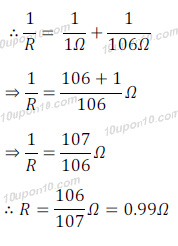
Thus, when resistance of 1Ω and 106 Ω are connected in parallel,
the equivalent resistance in circuit = 0.99 Ω
(b) 1 Ω and 103 Ω, and 106 Ω are connected in parallel:
Let, total effective resistance = R
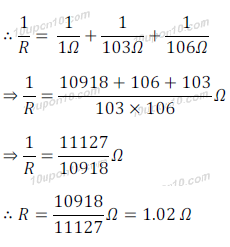
Thus, when 1 Ω and 103 Ω, and 106 Ω are connected in parallel,
The total equivalent resistance = 1.02 Ω
Question: 15. An electric lamp of 100 Ω, a toaster of resistance 50 Ω, and a water filter of resistance 500 Ω are connected in parallel to a 220 V source.
What is the resistance of an electric iron connected to the same source that takes as much current as all three appliances, and what is the current through it?
Answer:
Given,
R1 = 100Ω, R2 = 50 Ω, and R3 = 500 Ω
Potential difference, V = 220V
Let the total effective resistance in the circuit = R
Since appliances are connected in parallel
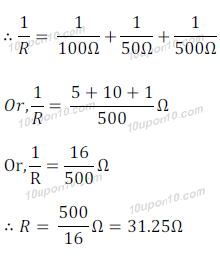
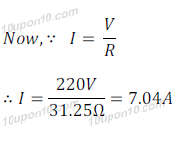
When electric iron connected to the same source,
Electric current through the circuit = 7.04A
(Since electric iron takes the same current as well as three appliances)
Potential difference = 220V
Let resistance of the electric iron = R
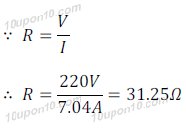
Since electric iron takes the current as well as three appliances together take and potential difference is same, thus the resistance of the electric iron is equal to the equivalent resistance of the three appliances connected in circuit, which is equal to 31.25Ω.
Question: 16. What are the advantages of connecting electrical devices in parallel with the battery instead of connecting them in series?
Answer: Advantages of connecting electrical appliances in parallel instead of connecting in series:
(a)Potential difference does not divided among the appliances, thus all electric appliances get equal voltage and work better.
(b)Separate switch can be attached with each of the electrical appliances so that any one can be switched off as per requirement keeping other operating.
(c) The total effective resistance of the circuit becomes lower than the resistance of appliances.
Question: 17. How can three resistors of resistances 2 Ω, 3 Ω, and 6 Ω be connected to give a total resistance of (a) 4 Ω, (b) 1 Ω?
Answer:
(a) Let two resistors 3 Ω and 6 Ω are connected in parallel and one 2Ω is connected in series. The diagram can be depicted as follows:
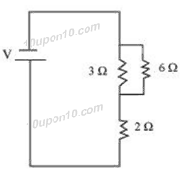
Let total effective resistance due to resistors in parallel = R1
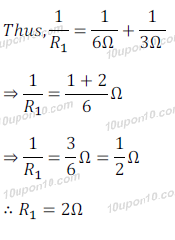
Now, total equivalent resistors of R1 and another resistor of 2 Ω are connected in series,
Therefore, total equivalent resistance in circuit (R)
= R1 + 2 Ω
= 2 Ω + 2 Ω = 4 Ω
Therefore, when resistors having resistance equal to 3 Ω and 6 Ω are connected in parallel and one having resistance equal to 2 Ω is connected in series, the total effective resistance in the circuit would be equal to 4 Ω
(b) Let all the three given resistors are connected in parallel,
Let the total effective resistance of the circuit = R
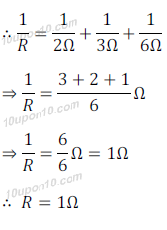
Thus, the total effective resistance of the circuit will be equal to 1 Ω if all the three resistance will be connected in parallel.
Question: 18. What is (a) the highest, (b) the lowest total resistance that can be secured by combinations of four coils of resistance 4 Ω, 8 Ω, 12 Ω, 24 Ω?
Answer:
When resistors are connected in parallel, then total effective resistance in the circuit is lowest. And when resistors are connected in series the total resistance of the circuit is equal to the sum of all of the individual resistors.
Let all the resistors are connected in parallel and the total effective resistance in the circuit is equal to R
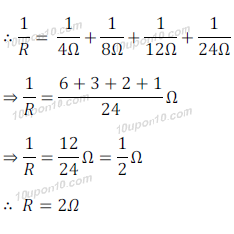
Let all the resistors are connected in series
Therefore the total effective resistance in the circuit (R)
= 4 Ω + 8 Ω + 12 Ω + 24 Ω = 48 Ω
Thus, when all the resistors are connected in series the total effective resistance = 48Ω
Thus,
(a) The highest resistance = 48 Ω
(b) The lowest resistance = 2 Ω
Question: 19. Why does the cord of an electric heater not glow while the heating element does?
Answer:
Since the resistance of the cord is very low while the resistance of the element of any heating device is very high and is meant to produce heat.
Therefore, because of very low resistance the cord of an electric heater does not glow while the heating element glows.
Question: 20. Compute the heat generated while transferring 96000 coulomb of charge in one hour through a potential difference of 50 V.
Answer:
Given,
Potential difference (V) = 50V,
Charge (Q) = 96000 coulomb
Time, t = 1 hour = 60 X 60 s = 3600 s
Heat produced (H) =?
We know that heat produced (H) = VIt
Thus, to calculate the heat produced, first of all electric current will be calculated.
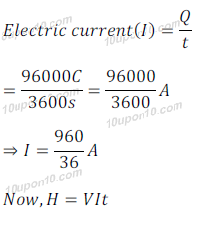
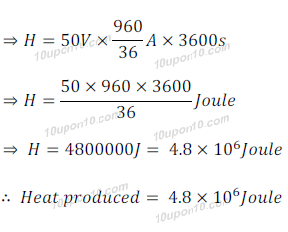
Question: 21. An electric iron of resistance 20 Ω takes a current of 5 A. Calculate the heat developed in 30 s.
Answer:
Given,
Electric current (I) = 5A,
Resistance (R) = 20 Ω,
Time (t) = 30s
Heat produced (H) =?
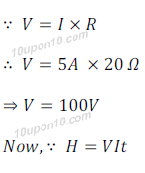
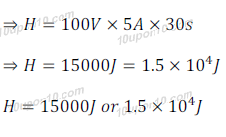
Question: 22. What determines the rate at which energy is delivered by a current?
Answer: Electric energy or power is the rate at which electric energy is dissipated or consumed.
Power is given by following equation:
P = V x I = Potential difference x Current
The above equation shows that potential difference and electric current determine the rate at which energy is delivered by a current. Since potential difference and current are the variables which determine the resistance of a conductor, so resistance is another determinant for the rate at which energy is delivered by a current.
Question: 23. An electric motor takes 5 A from a 220 V line. Determine the power of the motor and the energy consumed in 2 h.
Answer:
As per question,
I = 5A,
V = 220V,
t = 2h = 2 x 60 x 60 s = 7200 s
P =?
E =?
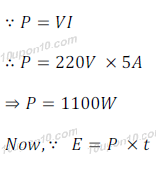
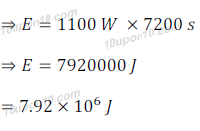
Therefore, Power (P) = 1100 W and Energy consumed = 7.92 x